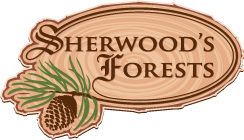Mountain Pine Beetle
Climate change in action...
A number of customers have asked if they should avoid planting pines because of the pine beetle.
This is not a new problem. MPB has flared up and died back repeatedly. It's currently on the rise in part because of warm winters, in part because of fewer forest fires, in part because of certain logging practices.
Almost all trees have some pest that attacks them. Many pests come and go in cycles. Currently, because of a series of warmer than average winters, the pine beetle population has grown. For pines, it can be MPB. For birch it can be leaf miner. For spruce it may be spruce bud worm.
A pine in good health is largely unharmed by the beetle. It will bore into the tree. The tree responds with a flood of pitch, and smothers the beetle.
A pine in poor health can't produce enough pitch.
But ...
(There's always a but.)
In a stand of older pine, near the end of their life
and we have a couple of warm winters, the beetle population explodes
This huge overpopulation of beetle can swamp nearby healthy pines
just because so many attack the tree that it runs out of sap.
Add one more victim.
In the normal year a lot of the beetle larva die off in winter cold. If you are a beetle above the snowline snug in the bark of a tree three weeks of -30 weather makes you an ex-beetle.
The beetle is subject to a bunch of predators, mostly small wasps, and a few diseases. These are effective at the normal population levels. They fall behind when the population explodes. By the time they catch up, it's too late for the pines.
What can I do?
Most susceptible forests:
Size: Trees larger than 8 inches are mature to over mature and are more at risk.
Age: Trees older than 80 years old.
Density: Stand densities of 750 to 1500 trees per acre (300 to 600 trees per acre) are more likely to be targeted.
Prevention
Plant mixed forests. You want to mix both species and age.
Plant at a lower density. Reforestation is commonly done on about a 10 foot grid, or about 440 trees per acre. Back that up to 14 foot spacing and the density goes down to about 200 trees per acre.
Keep your forests thin. Thin them to point where crowns don’t touch.
More information:
Oregon State University. This one has a fair bit of science in it, explaining how beetles are killed, and what contributes to survival. Resistance of Conifers to Bark Beetle Attack
Alternate Link if the above doesn’t work
Colorado State Extension Service Mountain Pine Beetle
Parks Canada: What is Mountain Pine Beetle?
Mountain Beetle Treatment Web Site
Recommendations
One of my clients is planting douglas fir. This works if you are in the foothills region, and your project coincides with the availability of suitable seedlings. We are marginal for doug fir here on the prairie. I have had reasonable success with seedlings produced for the West Kooteney district at high elevation, and for trees for the Prince George area.
If you are near an extensive area of pine forest that is fairly mature (most trees are more than 8" thick, more than 40 feet high, then you may want to hold off a bit on pines. Or you may want to plant pines now, hope that the beetles ignore them because they are so small, and when the epidemic dies out you can be the only person on the block with pines.
Bristlecone pine is somewhat less susceptible. Be prepared to wait. They are very slow growing trees. U.S. Forest Service News Release on Bristlecone Pine Resistance to MPB
Keep your pines healthy. Mostly this means reducing stress on them. Light, fertilizer, water, room. Take out the overcrowded ones.
Watch your pines for signs of infection. See article links above.
In general the beetles prefer older trees. Young trees (under 4-6" diameter are not attacked unless there are very large numbers of beetles.
While strong winds have carried beetles hundreds of kilometers, most beetles attack a nearby tree. If you have no major pine stands within 10-20 kilometers or so, the chances of a young pine getting an overwhelming exposure to beetle is small.
Focus on diversity. It's far more important in ecology than it is in economics. Pests have a much harder time spreading if their host is 20% of the landscape instead of 100% of the landscape. Use multiple species, at multiple ages.
Avoid mass plantings. It's easy for an infected tree to infect it's neighbor. Avoid formal arrangements -- a row of identical trees. If you have to remove an infected tree, there's a big hole in the landscape.
Got something to say? Email me: sfinfo@sherwoods-forests.com
Interesting? Share this page.
Want to talk right now? Call me: (8 am to 8 pm only, please) 1-780-848-2548
Do not arrive unannounced. Phone for an appointment. Why? See Contact & Hours That same page gives our hours of operation.
Back to Top
Copyright © 2008 - 2021 S. G. Botsford
Sherwood's Forests is located about 75 km southwest of Edmonton, Alberta. Please refer to the map on our Contact page for directions.
